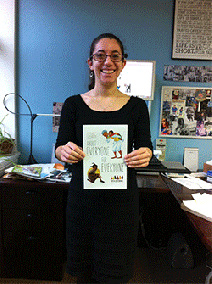 November is Native American Heritage Month, which is as good a time as any to discuss the slight issue we have with observance months. Native American Heritage Month and Black History Month, for example, were established to celebrate cultures that otherwise went ignored, stereotyped, or otherwise underappreciated. Educators often use these months as a reason to pull titles by/about a particular culture off the shelf to share with students.
November is Native American Heritage Month, which is as good a time as any to discuss the slight issue we have with observance months. Native American Heritage Month and Black History Month, for example, were established to celebrate cultures that otherwise went ignored, stereotyped, or otherwise underappreciated. Educators often use these months as a reason to pull titles by/about a particular culture off the shelf to share with students.
While we can generate a recommended reading list just as well as the next publisher, the problem we find with Native American Heritage Month is that it puts Native American books—and people—in a box. The observance month can easily lead to the bad habit of featuring these books and culture for one month out of the entire year. Ask yourself: Have we ever taken this approach with books that feature white protagonists?
On the other hand, observance months can definitely do some good: they remind educators to highlight the achievements of particular cultures, and can make students from those cultures feel acknowledged and appreciated. But wouldn’t it be better if that feeling and effort could be maintained all twelve months of the year?
For us, featuring diverse books throughout the year is second nature. Our approach is to dig deeper and go beyond just one month. We identify the various ways our books can apply to everyday, universal experiences and communicate this as widely as possible. We developed a ten-step process for becoming a more inclusive reader, part of a brochure that folds out to a poster (see right).
Educators stuck in the heritage month mindset can instead use the recommended book lists for those months as a jumping-off point to permanently diversify their collections. If you use particular books during a heritage month, ask yourself: What other themes does this book touch upon? How can I connect it to other parts of the curriculum or use it to teach additional skills?
Our book Buffalo Song by Joseph Bruchac is often included in roundups and recommendations for Native American Heritage Month. The book is a biography of Walking Coyote, who brought the buffalo herds of the American West back from the brink of extinction. While this book is certainly a good fit for Native American Heritage Month, it can also be used to teach about many other things, such as:
• Environmental conservation
• Nonfiction and biography
• Core values like perseverance and respect
Our literacy specialist even details ways it can be used in conjunction with trips to state and national parks.
Now here’s a challenge for you: Take the books used this month to celebrate Native American Heritage Month and brainstorm ways that they can be used throughout the year. We’d love to hear your thoughts in the comments below.
Filed under: Diversity 102, Diversity, Race, and Representation Tagged: African/African American Interest, Asian/Asian American, diversity, Educators, Latino/Hispanic/Mexican, Native American






The problem is that there are many thousands of books for educators to choose for their classes. While you are correct that a book like BUFfALO SONG can be presented to students during other months of the year, it fair to assume that without an Ethnic Heritage Month for this book, teachers are likely to choose other books and ignore it all together. But November gives this book a fighting chance to be presented to students because there is a special months just for a book like this. All in all, taking into account the many thousands of books … Ethnic Heritage Months are very useful for books written by and for a special group of minorities.
Hi Giora-
I agree with you that there are thousands of books for educators to choose for their classes (if they are given a choice at all!). Designated months for ethnic heritage and other groups create a time and space to reflect on and celebrate specific figures and contributions in history. We recognize that certain months may be the only time educators have available to infuse additional history topics and cultures into the curriculum. Thus, we are committed to the goals and legacy of Black History Month, Women’s History Month, Native American Heritage Month and more while at the same time to shining a light on a cultural group’s contributions to history and contemporary life all year round. We are always thinking about how to incorporate new thinking, perspectives, and activities into these theme- or group-specific months as well as general scope and sequence plans and multiple units within different teachers’ curricula. I agree with you that these designated months can be very useful. Indeed, these are another tool educators have to broaden the scope of diversity in the world of children’s literature and provide books that engage, inform, and excite all children. It is our hope that an educator discovers an incredible book during one of these months and further elevates it to the general curriculum or the tried-and-true read aloud bin.